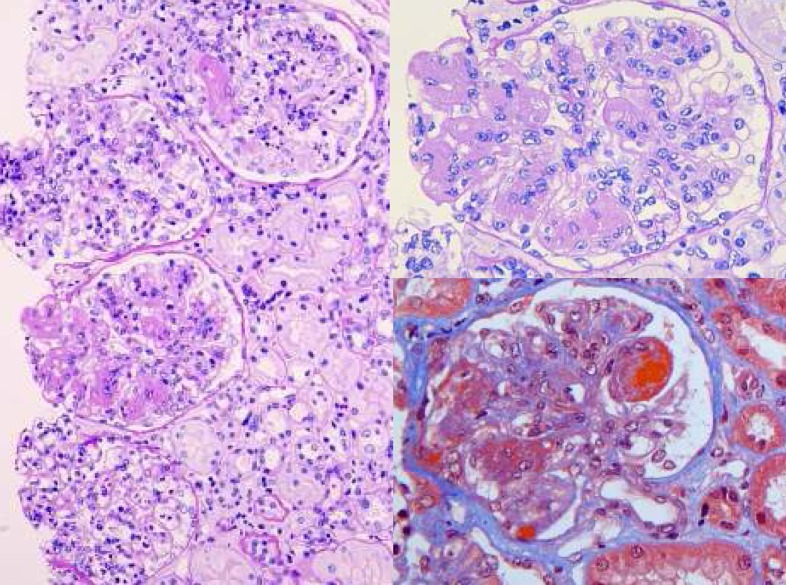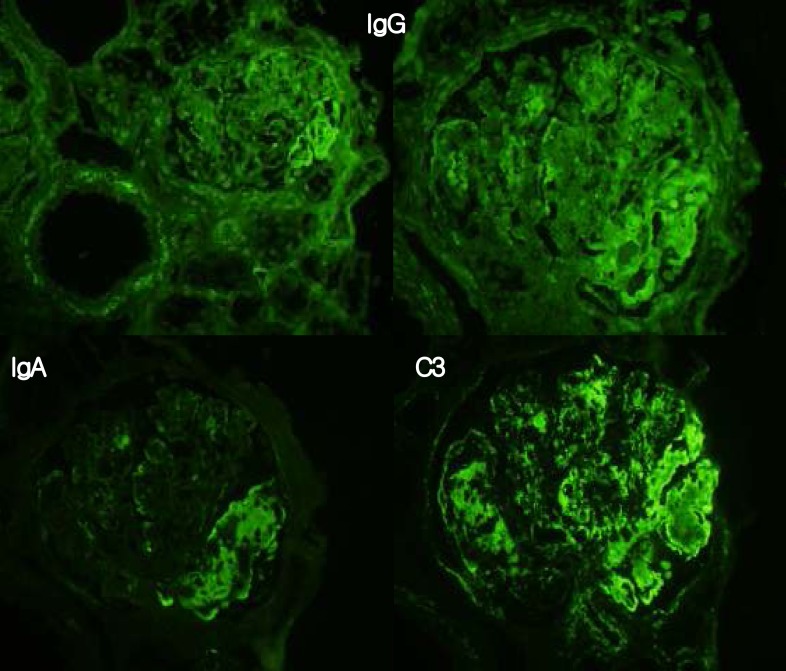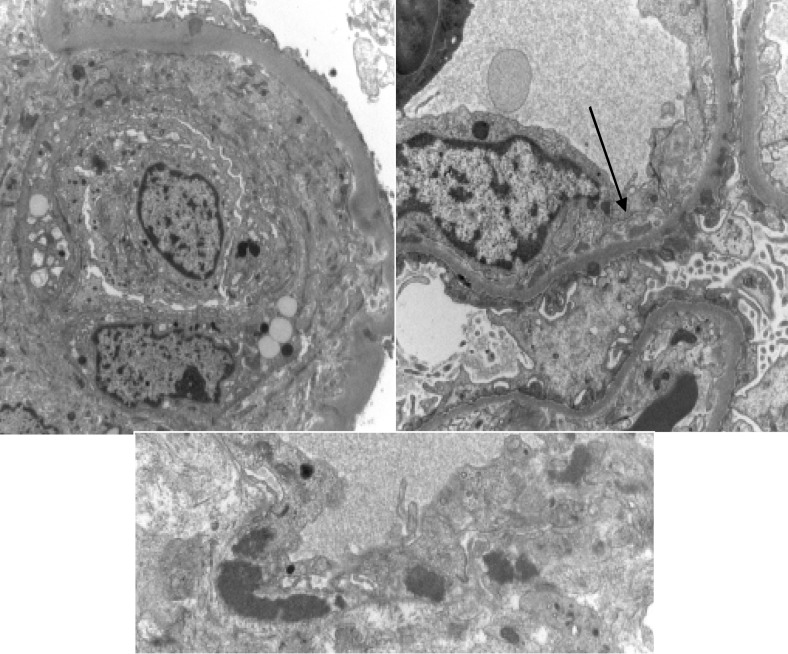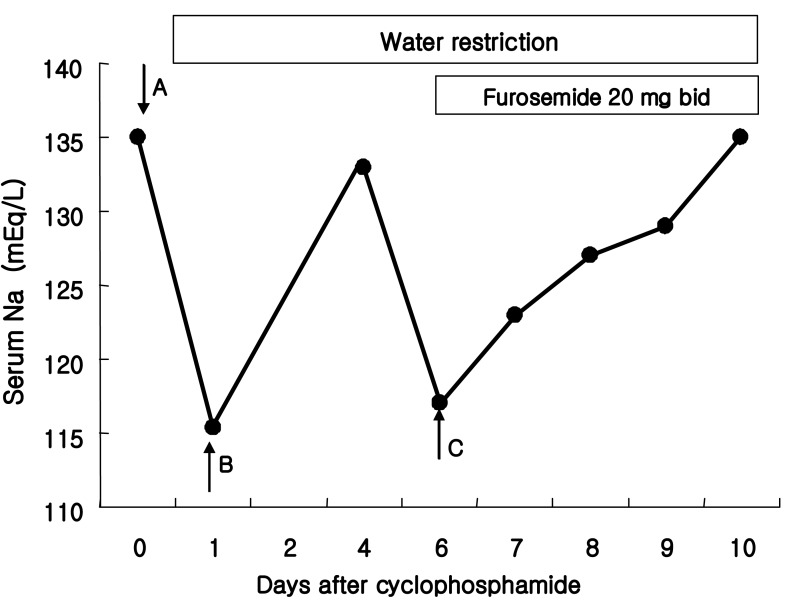Electrolyte Blood Press.
2007 Jun;5(1):50-54. 10.5049/EBP.2007.5.1.50.
Water Intoxication Following Low-Dose Intravenous Cyclophosphamide
- Affiliations
-
- 1Department of Internal Medicine, Hanyang University College of Medicine, Seoul, Korea. kimgh@hanyang.ac.kr
- 2Department of Pathology, Hanyang University College of Medicine, Seoul, Korea.
- KMID: 2134806
- DOI: http://doi.org/10.5049/EBP.2007.5.1.50
Abstract
- Cyclophosphamide is frequently used for the treatment of severe lupus nephritis, but is very rarely associated with dilutional hyponatremia. Recently we experienced a case of water intoxication following low-dose intravenous cyclophosphamide. Five hours after one dose of intravenous pulse cyclophosphamide 750 mg, the patient developed nausea, vomiting, and general weakness. Serum sodium concentration revealed 114 mEq/L and her hyponatremia was initially treated with hypertonic saline infusion. Then her serum sodium concentration rapidly recovered to normal with water restriction alone. During the course of intravenous pulse cyclophosphamide therapy, one must be aware of the possibility of significant water retention.
MeSH Terms
Figure
Cited by 2 articles
-
Life-Threatening Acute Hyponatremia with Generalized Seizure Induced by Low-Dose Cyclophosphamide in a Patient with Breast Cancer
Seong-Bae Hwang, Hye-Yoon Lee, Hoon-Yub Kim, Eun-Sook Lee, Jeoung-Won Bae
J Breast Cancer. 2011;14(4):345-348. doi: 10.4048/jbc.2011.14.4.345.The Role of Proximal Nephron in Cyclophosphamide-Induced Water Retention: Preliminary Data
Sua Kim, Chor Ho Jo, Joon-Sung Park, Ho Jae Han, Gheun-Ho Kim
Electrolyte Blood Press. 2011;9(1):7-15. doi: 10.5049/EBP.2011.9.1.7.
Reference
-
1. Webberley MJ, Murray JA. Life-threatening acute hyponatremia induced by low-dose cyclophosphamide and indomethacin. Postgrad Med J. 1989; 65:950–952. PMID: 2616440.2. Spital A, Ristow S. Cyclophospahmide induced water intoxication in a woman with Sjogren's syndrome. J Rheumatol. 1997; 24:2473–2475. PMID: 9415661.3. DeFronzo RA, Braine H, Colvin M, Davis PJ. Water intoxication in man after cyclophosphamide therapy. Time course and relation to drug activation. Ann Intern Med. 1973; 78:861–869. PMID: 4713567.4. Harlow PJ, DeClerck YA, Shore NA, Ortega JA, Carranza A, Heuser E. A fatal case of inappropriate ADH secretion induced by cyclophosphamide therapy. Cancer. 1979; 44:896–898. PMID: 476599.
Article5. Steele TH, Serpick AA, Block JB. Antidiuretic response to cyclophosphamide in man. J Pharmacol Exp Ther. 1973; 185:245–253. PMID: 4703820.6. DeFronzo RA, Colvin OM, Braine H, Roberson GL, Davis PJ. Proceedings: Cyclophosphamide and the kidney. Cancer. 1974; 33:483–491. PMID: 4812765.7. Bressler RB, Huston DP. Water intoxication following moderate-dose intravenous cyclophosphamide. Arch Intern Med. 1985; 145:548–549. PMID: 3977522.
Article8. McCarron M, Wright GD, Robert SD. Water intoxication after low dose cyclophosphamide. BMJ. 1995; 311:292. PMID: 7633237.9. Salido M, Macarron P, Hernandez-Garcia C, D'Cruz DP, Khamashta MA, Hughes GR. Water intoxication induced by low-dose cyclophosphamide in two patients with systemic lupus erythematosus. Lupus. 2003; 12:636–639. PMID: 12945725.10. Buckner CD, Rudolph RH, Fefer A, Clift RA, Epstein RB, Funk DD, Neiman PE, Slichter SJ, Storb R, Thomas ED. High-dose cyclophosphamide therapy for malignant disease. Toxicity, tumor response, and the effects of stored autologous marrow. Cancer. 1972; 29:357–365.11. Cohen JL, Jao JY, Jusko WJ. Pharmacokinetics of cyclophosphamide in man. Br J Pharmacol. 1971; 43:677–680. PMID: 5157730.
Article12. Kirch C, Garchot B, German N, Blot F, Nitenberg G. Recurrent ifosfamide-induced hyponatremia. Eur J Cancer. 1997; 33:2438–2439. PMID: 9616298.13. Pratt CB, Douglass EC, Kovnar EH, Heideman R, Kun L, Avery L, Kellie SJ. A phase I study of ifosfamide given on alternate days to treat children with brain tumors. Cancer. 1993; 71:3666–3669. PMID: 8490915.
Article
- Full Text Links
- Actions
-
Cited
- CITED
-
- Close
- Share
- Similar articles
-
- Hyponatremia caused by excessive intake of water as a form of child abuse
- A Case of Diffuse Leukoencephalopathy Following Low Dose Intravenous Methotrexate Therapy
- Effect of Cyclophospharmide Pulse and Combined with Per Oral Low Dose Glucorticoid on Pulmonary Fibrosis in Patient with Sistemic Sclerosis
- Severe Symptomatic Hyponatremia Caused by Low Dose Oral Cyclophosphamide: A Case Report
- Two Cases of Refractory Thrombocytopenia in Systemic Lupus Erythematosus that Responded to Intravenous Low-Dose Cyclophosphamide





